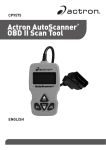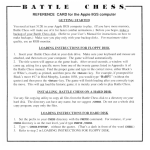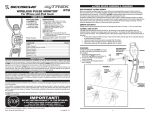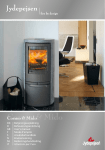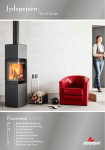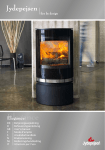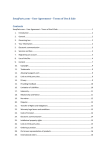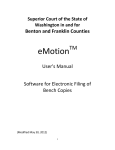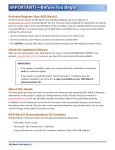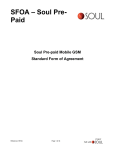Download RI CIT Re-Certification Training
Transcript
Welcome to the Rhode Island Vehicle Inspection and Maintenance Program 2012 Inspector Re-certification 1 1 RI Inspector Training Outline I. Why Does RI Need an Emission Inspection Program? II. Safety Inspection Procedure Review III. Review Emissions Testing Procedures IV. Review Purpose of OBD V. Review Emissions I/M Program Requirements VI. Review Emissions Waiver Process VII. Conclusions VIII. Resources 2 Vehicles Subject to Emissions and Safety Testing • RI I/M Program requires the following vehicles pass an emission and safety inspection every two years: – All gasoline and diesel powered light duty passenger vehicles and light duty trucks with a GVWR of 8,500 pounds or less . – Vehicles 25 years old or older • Must pass safety inspection and be emission tested but are not required to meet the standards. * New vehicles must be inspected within 2 years of the date of purchase or when the vehicle accumulates 24,000 miles, whichever occurs first 3 Why Does RI Need an Emission Inspection Program? • • • • • • Proper maintenance of a car's engine and pollution control equipment is critical to reduce excessive air pollution. Motor Vehicles contribute 51% of man-made pollutants that contribute to the formation of ozone. Breathing ozone can trigger a variety of health problems. Reduction of ground level “bad” ozone protects our health. EPA 8-hour ozone standard is designed to be protective of human health. To help ensure that such maintenance occurs, the Clean Air Act requires certain areas with air pollution problems to run inspection and maintenance (I/M) programs. Emissions Reductions since 2000-2013 • Since the I/M Program began in 2000, there has been a 31% reduction in emissions as a result of the I/M Program. • During 2000 the average NOx reductions were only 38.50%. • During 2013 the average NOx reductions were 70%. 4 Why Does RI Need an Emission Inspection Program? Air Quality Bad Air Quality Day Photo Good Air Quality Day Photo 5 Why Does RI Need an Emission Inspection Program? What is Ozone? • Ozone is a gas composed of 3 oxygen atoms • “Good” ozone is produced naturally in upperatmosphere where it protects the Earth from the sun’s UV rays • “Bad” ozone is formed at the Earth’s surface where it causes health problems in humans and damage to plant species 6 Why Does RI Need an Emission Inspection Program? Ozone The ozone layer in the upper atmosphere is beneficial, preventing potentially damaging ultraviolet light from reaching the Earth's surface EARTH Yes This IS A HOLE! 7 Why Does RI Need an Emission Inspection Program? Why Is Ozone a Concern? Breathing ozone is harmful to human health •Irritates respiratory systems •Aggravates asthma, emphysema and bronchitis •Inflames and damages linings of lungs People most susceptible include •Those with respiratory illnesses, •Older adults, •Children who are active outdoors • And Even Healthy adults 8 Why Does RI Need an Emission Inspection Program? How is ground-level Ozone (Smog) formed? • Ground-level ozone is formed by a chemical reaction between volatile organic compounds (VOCs) and oxides of nitrogen (NOx) in the presence of sunlight. Ozone concentrations can reach unhealthful levels when the weather is hot and sunny with little or no wind. 9 Why Does RI Need an Emission Inspection Program? What is NOx ? Nitrogen Oxides are a family of poisonous, highly reactive gases. These gases form when fuel is burned at high temperatures. NOx pollution is emitted by automobiles, trucks and various non-road vehicles (e.g., construction equipment, boats, etc.) as well as industrial sources such as power plants, industrial boilers, cement kilns, and turbines. NOx often appears as a brownish gas. It is a strong oxidizing agent and plays a major role in the atmospheric reactions with volatile organic compounds (VOC) that produce ozone (smog) on hot summer days. 10 Why Does RI Need an Emission Inspection Program? What are Vehicle VOCs? • Volatile organic compounds (VOCs) are emitted as gases from certain solids or liquids. VOCs include a variety of chemicals, some of which may have short- and long-term adverse health effects. Sources of Vehicle VOCs include: •Fuel Evaporation –Fuel Supply Line Leaks –Gas Cap Seal Leaks –Evaporative Emissions System Malfunctions •Vehicle Exhaust Product •Incomplete Fuel Combustion 11 Why Does RI Need an Emission Inspection Program? Ozone in Rhode Island • • • The Department of Environmental Management (DEM) provides a daily ozone forecast from April through September for all Rhode Islanders. When the ground-level ozone is elevated to unhealthy levels, the RIPTA buses and trolleys are free to ride on those days. The results of the forecast are announced on the local news channels and can also be found on the DEM website: www.dem.ri.gov 12 Safety Inspection Procedures It is expected that you are familiar with the standards and procedures set forth in the RI Official Manual for Vehicle Inspection. Always follow the guidelines and procedures set forth in the RI Official Manual for Vehicle Inspection When in doubt refer to the manual! If the issue or item is still not clarified, call the safety and Emission Control Office at 462-5890 for assistance Copies of the RI Official Manual for Vehicle Inspection can be obtained from the following locations. • Safety and Emissions Control Office • DMV Website • On the inspection machine 13 Safety Inspection Procedures Vehicle Safety Inspection Motor Vehicles up to 8500 lbs. GVWR Items to be inspected include (but are not limited to): 1. ABS Light 17. Emergency brake 2. Air bag light 18. Emissions 3. Back up lamps 19. Exhaust system 4. Ball joints 20. Fenders and flaps 5. Body items 21. Floor and other panels 6. Brakes (ABS) 22. Fuel tank – cap 7. Brake drums and discs 23. Glass 8. Brake failure warning lamp 24. Hazard switch 9. Brake lining or pads 25. Headlamps 10. Brake performance 26. Height altered 11. Brake pedal reserve 27. Horn 12. Bumper (rear end protection) 28. Master cylinder 13. Check engine light 29. Mirrors 14. Clearance lamps 30. Parking lamps 15. Directional signals 31. Parking brakes 16. Door (front latches) 32. Plates and plate light 33. Reflectors 34. Registration certificate 35. Seat belts 36. Seats 37. Side market lamps 38. Springs, torsion bars, shocks 39. Steering, alignment and suspension 40. Stop lamps 41. Tail lamps 42. Tires 43. Transmission 44. Universal joints 45. Wheels 46. Wheel safety chock blocks 47. Windshield wipers 48. Windshield Remember: Inspection regulations are designed to prevent continued use of defective emissions and safety equipment so that at least one time during the required inspection cycle a vehicle is inspected by qualified personnel to ascertain that the vehicle is properly equipped for continued use. The inspector is not guaranteeing that any particular component will last until the expiration of the inspection sticker, but rather that the components meet minimum standards at the time of the inspection and the vehicle owner is maintaining the vehicle properly. 14 Safety Inspection Procedures License Plates, Registrations and License Plate Validation Stickers • Check for Valid Registrations, Proper Display of License Plates and Current Validation Stickers • All vehicles presented for inspection must have a valid registration or dealer plate at the time of inspection. • All registered vehicles (except Farm Vehicles, Motorcycles and Trailers), must have 2 plates properly affixed with current validation stickers. • Check that the V.I.N. from the registration matches the vehicle, if it does not match, refer customer to DMV to correct the issue prior to inspection. 15 Safety Inspection Procedures Window Tint Passenger Cars • • • • All Passenger Cars must have a visible light transmittance of 70% on all windows. This includes tint installed within the glass from the vehicle manufacturer. Most OEM glass on passenger vehicles is tinted within 5% of the limit; any aftermarket tint added will bring the light transmittance below 70%. (see photo) Refer to section 3.13, GLASS in the RI Official Manual for Vehicle Inspection for details. Light transmittance reading of factory glass with no aftermarket tint installed. Note: reading must be 70 or above to be approved. 16 Safety Inspection Procedures Window Tint Exemptions • MPVs (Multi Purpose Vehicles), (SUVs), Trucks, Vans, Buses, Trailers, Campers, Funeral Vehicles, Limos: – The windows to the left and right of the driver along with the windshield must meet the 70% transmittance. – All other windows are exempt as long as the vehicle is equipped with two outside mirrors. • • Motor vehicles owned or leased by Federal, State and Local Law Enforcement Agencies. Vehicles issued a medical exemption issued by the Operator Control Section of DMV. When in doubt check the manufacturer’s vehicle information tag to determine the vehicle type. *Medical exemptions do NOT apply to the windshield below the AS-1 mark 17 Safety Inspection Procedures Windshield Tint No Windshield Tint Allowed Any aftermarket tint installed below the AS-1 line (or more than 6 inches from the top of the windshield if there is no marked AS-1) will bring the light transmittance below 70% and is prohibited. 18 Safety Inspection Procedures Exhaust Systems • Any exhaust that has been modified, deleted, or adjusted that causes the sound level to be louder than the manufacturers original equipment is cause for rejection. 19 Safety Inspection Procedures Body and Frame Rust Common Causes for Rejection: • Body frames • Chassis • Structural issues • Running boards • Floor boards including: – Trunk bottoms and other parts of the vehicle that are rusted out should be rejected if they are considered dangerously damaged or, if they allow any fumes to enter the passenger compartment. • When it’s a judgment issue and you’re not sure whether the damage is severe enough to be cause for rejection, call DMV or fail the vehicle and refer the owner to DMV. • Specify defects on the vehicle inspection report. 20 Safety Inspection Procedures Always Check For: Frame rot and structural integrity Rotted or broken suspension components 21 Safety Inspection Procedures Always Check For: Severely corroded, cracked, or broken brake lines and hoses Rotted fuel lines 22 Safety Inspection Procedures Seat Belts and Air Bags Remember to check for proper functionality of seat belts and SRS (Air Bag) systems Seat belts are the single most effective traffic safety device for preventing death and injury, according to the National Highway Traffic Safety Administration. Wearing a seat belt can reduce the risk of crash injuries by 50 percent. Seat belts and Air Bags save lives. All Motor Vehicles beginning with the 1964 models are required to have seat belts. The seat belts and SRS systems should be checked to make sure they are equipped as they were from the vehicle manufacturer and are working properly. 23 Safety Inspection Procedures Alternate Inspection Approval To be used only in the following scenarios: • Unregistered vehicles which have been denied registration or renewal due to an Inspection related issue • A suspended vehicle for which the license plates and registration have been seized by law enforcement or DMV If a current RI vehicle registration is presented and at least 1 registration plate is present, a full safety and emissions test is to be performed regardless of suspension status. (2 plates are required to pass) NEVER SIGN OFF ON ANY FORMS UNTIL COMPLETELY FILLED OUT 24 Emission Testing Procedures Emission Testing Procedures 1. Drive vehicle into inspection bay a. All emission tests must be performed with the vehicle in the view of the inspection video camera b. Videos may be reviewed for any test deemed suspicious or under investigation by DMV 2. Inspector logs in with CIT credentials a. CITs must use fingerprint reader to verify credentials 3. Data Entry: a. Registration Entry i. Verify registration is valid (not expired) ii. Verify registration matches plates on vehicle and vehicle VIN) b. VIN Entry i. Plug into OBD DLC to obtain VIN and perform test (Model Years 1996 and newer) ii. Barcode VIN iii. Manual Entry c. Verify VIN matches vehicle AND registration d. Verify/Enter Vehicle Data 4. Perform Gas Cap Test/Inspection a. Software will determine if test is needed 5. Record Safety Inspection Results 6. Perform MIL bulb check (KOEO/KEOR) a. Record MIL illumination results KOEO b. Record MIL illumination results KOER 7. Perform Emissions Test (if not completed in step 3) a. OBD II Test – MY (Model Years) 1996 and newer (1997 and newer Diesel powered vehicles) b. Transient Test (MY 1995 and older gas, MY 1996 and older Diesel) i. Do not perform if dyne testing is unsafe c. TSI test i. To be performed when inspector determines vehicle characteristics prohibit transient testing due to risk of vehicle damage 8. Test Completion - Pass a. Print sticker, verify and barcode sticker number into software b. Verify that VIN on sticker matches registration/vehicle VIN c. Remove existing inspection sticker(if present) and clean windshield to facilitate adherence of new sticker d. Place new sticker in lower right corner of windshield e. Print VIR and provide to customer 9. Test Completion - Fail a. Print VIR and provide ALL PAGES to customer b. Inform customer of Safety and or Emission defects found c. Inform the customer of right to free retest within 30 days 25 Emission Testing Procedures Drive Vehicle Into Inspection Lane • All emission testing must be performed in view of the video camera in the inspection lane/bay to maintain program integrity. • Videos may be reviewed for any test deemed suspicious or under investigation by DMV • Failure to comply may result in suspension of Inspector and or Station license 26 Emission Testing Procedures Inspector Login All CITs are required to login and verify their identity by means of the fingerprint reader • • • Bypassing the fingerprint reader may lead to CIT lockout Bypassing the fingerprint reader will flag DMV Repeatedly bypassing the fingerprint reader will lead to suspension of password based access Password Security • Your password is your electronic signature • Never share your password • Never leave your password written on or near the analyzer • Periodically review tests performed for familiarity – Tests may be reviewed from within the analyzer by selecting: Utilities Menu > Document Printing > VIR Reprint • Passwords may be changed by contacting Opus • Inspectors will be held responsible for all tests performed under their name. 27 Emission Testing Procedures Data Entry Always make sure the data entered into the analyzer is correct. Verify that the V.I.N., plate number and plate type entered match the vehicle and registration exactly. Failure to do so may result in: •Suspension of the vehicle registration •Vehicles being towed •Re-inspecting the vehicle at the stations expense If the V.I.N. from the registration does not match the V.I.N. tag on the vehicle, do not proceed with the test and refer customer to DMV to correct the issue prior to inspection. Common mistakes: •Not verifying V.I.N.s after electronically obtaining (i.e. door changed, PCM changed etc.) •Wrong plate numbers and or plate types entered •Digit missed or extra digit in the V.I.N. entered •(Most 1981 and newer vehicles will have 17 digits) 28 Emission Testing Procedures Fuel Cap Test/Inspection • Always perform visual inspection of fuel cap All gasoline powered vehicles 1995 and older will receive a Gas Cap Pressure Leak Test. The test will ensure the gas cap on the vehicle is capable of properly sealing the gas tank allowing the vehicle’s evaporative emission system to properly dispose fuel vapors. Missing or malfunctioning gas caps will cause the vehicle to FAIL the emissions test Fuel caps prevent vapors from leaking out of the gas tank that would pollute the atmosphere, causing damage to the ozone. Proper use of the gas cap also increases fuel economy by effectively eliminating gas evaporation. 29 Emission Testing Procedures Recording of Safety Inspection Results • Record Safety Inspection Results by Category • List all Defects Found • List Defects Clearly within comments Remember: Complete the Inspection! Do not assume the vehicle will pass inspection if the MIL is not on! • When a vehicle is presented for inspection, the complete inspection should always be performed regardless of M.I.L. status. • This provides a complete picture of all required repairs to the vehicle owner – Mechanical repairs needed – Emission related repairs needed – M.I.L. lamp malfunctions 30 Emission Testing Procedures Perform MIL Bulb Check Key On/Engine Off (KOEO) •Turn the ignition to the run position but do not start the engine •Check for illumination of the M.I.L. •Inspectors must fail a vehicle during the bulb check test if the MIL does not illuminate with the key in the on position and the engine is off. What if the vehicle has a key FOB (Proximity Key)? • • • Some vehicles have a FOB that does not have to be pressed to enter or drive the vehicle, this may make it difficult to perform a “Bulb Test” “Keyless Ignition” vehicles do have a means to perform “Bulb Test” to check the MIL Consult the owners manual for manufacturer’s guidelines for performing bulb checks on these vehicles 31 Emission Testing Procedures Perform MIL Bulb Check Key On/Engine Running (KOER) •Start the engine •Check for illumination of the M.I.L. •Inspectors must fail a vehicle during the bulb check test if the MIL is illuminated while the key is in the on position and the engine is running (even if there are no DTCs present) 32 Emission Testing Procedures Perform Emissions Test Perform the Emission Test Required for the Vehicle Type • OBD II Test • • • Model Years 1996 and newer Gas powered 1997 and newer Diesel powered vehicles NOTE: OBD test may have been completed at the time of OBD VIN Capture • Transient Test • • • Model Years 1995 and older gasoline powered Model Years 1996 and older diesel powered (Diesel opacity test) Do not perform if dyne test is unsafe • Two Speed Idle (TSI) test • Model Years 1995 and older gasoline powered: To be performed when inspector determines that vehicle characteristics prohibit transient testing due to risk of vehicle damage. ( AWD, non-disengageable traction control, etc.) • Optional test for vehicles 25 or more model years old 33 Emission Testing Procedures Test Completion - Pass • • • • • Print sticker, verify and barcode sticker number into software Verify that VIN on sticker matches registration/vehicle VIN Remove existing inspection sticker(if present) and clean windshield to facilitate adherence of new sticker Place new sticker in lower right corner of windshield Print VIR and provide to customer Test Completion - Failure • • • Print VIR and provide ALL PAGES to customer Inform customer of Safety and or Emission defects found Inform the customer of right to free retest within 30 days 34 Emission Testing Procedures Turn Away Document • • • (non-OBD II vehicles) Provide this document to the vehicle owner to explain what is prohibiting the vehicle from being inspected. Used only when vehicles have physical defects that prohibit the completion of the test. Exhaust system defects that would cause dilution errors, Space saver tire on drive axel, etc Vehicles presented for inspection should be fully inspected whenever possible. 35 Emission Inspection Program OBD II • The Clean Air Act of 1990 established the requirement that passenger vehicles be equipped with on board diagnostics. The diagnostics system is designed to trigger a dashboard "check engine" light alerting the driver of a possible pollution control device malfunction. To help ensure that motorists respond to the "check engine" light in a timely manner, the Act requires that I/M programs include an inspection of the on board diagnostic system. Purpose: • Prevent excessive emissions by identifying emissions control aspects that fail to meet manufacturer established parameters and alerting the driver to the problem • Improve inspection and diagnostic processes by standardizing: – Component terms – Data Link Connector (DLC) location, shape and pin assignment – Diagnostic Trouble Codes (DTCs) 36 Emission Inspection Program OBDII Majority of RI tests are now OBDII tests 2013 RI TEST COUNTS OBD (1996 and newer) OBD Diesel Transient (MY<1996) TSI (AWD etc.) Diesel TSI Total Initial Tests 317,144 1262 12830 7722 149 339,107 37 Emission Inspection Program OBD II Operation • • • OBD II monitors actively evaluate performance of vehicle emissions control systems and components Problems noted by the OBDII computer will cause a DTC to be stored and the malfunction indicator lamp (MIL) will be commanded to illuminate Emission testing equipment uses this information to determine pass or fail OBD II Hardware • O2 Sensor(s) behind catalytic converter • • Enhanced power train control module PCM • • Allows flash reprogramming Upgraded crank sensor resolution • • Allows flash reprogramming EPROM Memory • • Needed to manage OBD II software and network EPROM Memory • • Monitors catalytic converter efficiency Enhances misfire monitoring Standard location and 16 pin terminal for DLC • Required to be within 18’’ steering column 38 Emission Inspection Program Vehicles Subject to OBDII Testing • Gasoline powered motor vehicles – 1996 and newer vehicles – up to 8,500 lbs. GVWR • Diesel powered motor vehicle – 1997 and newer vehicles vehicles up to 8500 lbs. GVWR are to be OBDII tested. (1996 and older diesel vehicles up to 8500 lbs. must be tested at a diesel opacity equipped station. The current list of diesel opacity equipped stations can be found at WWW.RIINSPECTION.ORG) 39 Emission Inspection Program Data Link Connector • Vehicles will fail the OBD test if the DLC is: – Tampered with • pins damaged or missing • used as a power source for other items on vehicle – Blocked by aftermarket equipment installation – Not located where the manufacturer installed the DLC – Not powered as required at pin 16 Example of a Data Link Connector (DLC) 40 Emission Inspection Program Readiness Monitors What are readiness monitors? Monitors are testing exercises, performed by the PCM, which are very carefully designed to indicate that all of the sensors within a portion of the engine management system are working properly to minimize emissions. Each monitor is run by the PCM under very specific vehicle operating conditions. Because of this, all monitors may not run each time the vehicle is driven. A given monitor may not run for quite some time, until the exact combination of conditions occurs to trigger it. This set of conditions is called the enabling criteria for the monitor and may include: operating temperature, RPM, load, etc. Types of Readiness Monitors Continuous: These monitors run all the time as long as the key is turned on and/or the engine is running. There are three continuous monitors that every OBDII equipped vehicle has, they are the Comprehensive Component Monitor, The Fuel Monitor and the Misfire Monitor. Non-Continuous: These monitors require certain conditions such as speed, acceleration/deceleration, fuel level, ambient and other conditions to be met in order for the monitor to run its testing sequence. If the specific conditions are not met, then the monitor will not perform its tests and cannot report as to whether or not there are any problems. Non-continuous monitors include the Catalyst, Heated Catalyst, Evaporative System, Secondary Air System, Air Conditioning (A/C) System, Oxygen (O2) Sensor, Heated O2 Sensor and Exhaust Gas Recirculation (EGR) System. 41 Emission Inspection Program Readiness Status • Readiness Status indicates if a monitor test has been run or not • This may be displayed as • • Yes/No • Ready/Not Ready • Complete/Not Complete Readiness Status does not indicate Pass or Fail - only that the test has been run Communications • The OBDII emission test requires successful communication with vehicle’s OBD computer • The Inspector does not determine result • Vehicles will fail for communications during the initial test if: – The vehicle does not transmit the necessary information to the inspection equipment after the analyzer completes the three OBDII data retrieval attempts – The analyzer reports failed communications – Pin 16 of the DLC is not powered 42 Emission Inspection Program Readiness Monitor Descriptions • Below are the basic OBDII monitors and the components and subsystems that they monitor. • Remember, not all vehicles have all of these monitors. If a vehicle is not equipped with or not designed to have a certain monitor, that monitor is “Unsupported.” Unsupported monitors do not affect the results of the emissions inspection. • Misfire: This monitor looks for any engine misfires. A misfire is when the air/fuel mixture in the engine’s cylinder does not ignite. This condition can cause damage to the vehicle’s engine and/or catalytic converter. In the case of a severe misfire condition, the OBDII system will cause the Malfunction Indicator Lamp to flash indicating a serious threat of damage to the catalytic converter. In the case of a flashing Malfunction Indicator Lamp, the operator should reduce speed and seek diagnostic and repair services as soon as possible. • Fuel System: This monitor constantly checks the amount of fuel that is used by the engine. Through the use of an oxygen sensor(s), the OBDII system can determine if more or less fuel is needed. This fuel adjustment is performed many times a second and helps to maximize fuel economy and minimizes harmful emissions. • Comprehensive Component: This monitor is looking at all of the various switches and sensors that are involved with engine management. It looks for voltage readings, resistance readings, and other conditions. The monitor records readings from the vehicle’s components and compares them with programmed values that reflect what the readings should be. If they differ by a certain amount, then that component is determined to be suspect. • Catalyst (also know as catalytic converter): This monitor uses the readings from oxygen sensors located before and after the catalyst(s) to determine the efficiency of the catalyst. • Heated Catalyst: Some vehicles may have an electrically heated catalyst. This heater helps warm up a cold catalyst faster so that it can start working sooner which leads to earlier reduction of harmful emissions. This monitor will check to make sure that the catalyst heater is working . 43 Emission Inspection Program Readiness Monitor Descriptions • Evaporative System: This monitor works to ensure that the Evaporative System is kept in a condition to minimize the release of gasoline vapors. • Secondary Air System: Some vehicles are equipped with a secondary air system, or air injection system. The air injection system is designed to place extra oxygen into the exhaust stream to reduce exhaust pollutants. This monitor checks the components, switches, and solenoids that are part of the air injection system. • A/C (Air Conditioning) System: In some older vehicles, this monitor was intended to monitor the vehicle’s air conditioning system if it had the older “R-12” style of refrigerant. Since R-12 is harmful to the ozone layer of the earth’s atmosphere, a leaking air conditioning system needed to be repaired as soon as possible. Several years ago, R-12 was banned from use; therefore, this monitor will show up as “Unsupported” on most newer vehicles. • O2 (Oxygen) Sensor: The O2 Sensor Monitor watches for the performance of the vehicle’s oxygen sensors. Oxygen sensors are used to fine tune the amount of fuel that is used by the engine. These adjustments are made several times a second and have a direct impact on fuel economy and emissions reductions. When an oxygen sensor goes bad, the vehicle will usually begin to use more fuel than it needs to, thereby increasing the amount of harmful emissions. • Heated O2 (Oxygen) Sensor: Some oxygen sensors include an electric heater to help them warm up quicker and to begin operating faster. This monitor ensures that the heater circuit of the oxygen sensor is working properly. Since not all vehicles have a heated oxygen sensor, some vehicles will show this monitor as “Unsupported.” • EGR (Exhaust Gas Recirculation) System: Many vehicles are equipped with an EGR system. This emissions control system is designed to reduce nitric oxide tailpipe emissions by reducing the temperature inside the engine’s combustion chamber. This monitor checks the components of the EGR system to ensure that it is working properly and that there is sufficient flow of exhaust gas through the system. 44 Emission Inspection Program Readiness Monitors Failures • Vehicles will fail for readiness if: – More than 2 monitors are ‘Not Ready’ on 1996 - 2000 model year vehicles – More than 1 monitor is ‘Not Ready’ on 2001 and newer model year vehicles • The Readiness Indicators will all be set to “Not Ready” if the DTC’s are erased or by loss of battery power • Common causes of “Not Ready” Monitors: – DTCs erased - Battery Replacement - Blown Fuse to PCM - Battery disconnected for vehicle service Setting Readiness Monitors The purpose of completing an OBD II drive cycle is to force the vehicle to run its onboard diagnostics. Some form of a drive cycle needs to be performed after DTCs have been erased from the PCM’s memory or after the battery has been disconnected. Running through a vehicle’s complete drive cycle will “set” the readiness monitors so that the vehicle will pass inspection or faults can be detected. Drive cycles vary depending on the vehicle and the monitor that needs to be re-set. Whenever possible, follow the drive trace prescribed for the specific vehicle/monitor in question. Some vehicle-specific drive cycles can be found in the vehicle’s service manual. • It is the vehicle owner’s responsibility to set the Monitors • It is not part of the Emission Test procedure • The vehicle is tested as received 45 Emission Inspection Program Generic Drive Cycle Although Drive cycles vary slightly among manufacturers, the following generic drive cycle can be used in most cases: • • • • • • • • This generic OBDII drive cycle begins with a cold start (coolant temperature below 122 degrees F and the coolant and air temperature sensors within 11 degrees of one another). This condition can be achieved by allowing the vehicle to “sit” overnight, and then by beginning the drive cycle the next day. Most drive cycles will be difficult to follow exactly under normal driving conditions, so the driver should exercise caution, road safety, and courtesy to others. Start the engine. Idle the engine in drive for two and a half minutes with the A/C and rear defroster on. Turn the A/C and rear defrost off, and accelerate to 55 mph at half throttle. Hold at a steady speed of 55 mph for three minutes. Decelerate (coast down) to 20 mph without braking or depressing the clutch. Accelerate back to 55 to 60 mph at ¾ throttle. Hold at a steady speed of 55 to 60 mph for five minutes. Decelerate (coast down) to a stop without braking. 46 Emission Inspection Program Drive Cycle Problems • • If the MIL illuminates while trying to run the Monitors, it means a code has set and a repair is necessary prior to passing inspection. If the Monitors will not run; – Check TSB’s – Follow the “Enabling Criteria” for the Monitor that will not run. – Obtain specific Drive Cycle information and follow it. Readiness Exception Vehicles Vehicles that are on the readiness exception list Maintained EPA will be forced into a tailpipe emissions test. – Analyzer will invoke the Dyne/TSI prompt and request that the inspector perform a tailpipe emissions test – Initial test and / or retest – Example = 1996 Chrysler Cirrus 2.4 – EPA maintains the list of these vehicles 47 Emission Inspection Program OBD Bypass Authorization Inspectors may request state approval to retest a vehicle with monitors not ready using a tailpipe emissions test when all reasonable methods to set the monitors have been exhausted including: •Proper drive cycle having been performed •All enabling criteria having been met •The vehicle has been driven for a sufficient time period and distance to set the monitors •No DTCs are present State approval must be received prior to performing the test. Contact the safety and emission control office at (401) 462-5890 48 Emission Inspection Program Diagnostic Trouble Codes Vehicles fail the DTC test if: – The OBD system has stored at least one (1) mature (nonpending, non-historic) DTC that commands the MIL to be illuminated – The vehicle commands the MIL to be illuminated but the OBD system has no mature DTCs stored in the system DTC Identification – OBD II codes (emissions related) are found in the PCM and will start with a “P” (Power train Control Module) – Codes that start with a “U” prefix are communication codes – They can indicate a problem with code and data transmission on the DLC (data link connector) 49 Emission Inspection Program 50 Emission Inspection Program DTC Types TYPE A Emissions related. Requests illumination of the MIL on the first trip with a fail. Stores a HISTORY DTC on the first trip with a fail. – Typically misfire codes – MIL Light will flash during misfire TYPE B Emissions related. “Pending" after one trip with a fail. "Disarmed" after one trip with a pass. Requests illumination of the MIL on the second consecutive trip with a fail. 51 Emission Inspection Program Emission Retesting Process Vehicles will be retested once at no cost to the motorist when: • Performed at the same station as the initial test • Performed within 30 days of the initial test • This 30 day period does NOT automatically extend any pending DMV suspension Motorist Options After Retest Failure Always inform vehicle owners of their options after failure •Repairs / Additional Repairs •Apply for a waiver from the Department of Motor Vehicles •Cost limit waiver •Time delay waiver •Diagnostic waiver 52 Emission Inspection Program Emissions Waivers • Vehicles must meet safety inspection requirements • No repair costs (parts or labor) for repairing tampered or missing emission control equipment will be applied toward the emission waiver. • Refer the customer to the DMV (contact info on the VIR) for waiver consideration • The department will verify that the repair receipts or invoices submitted meet the requirement, that the repairs indicated on the itemized receipts for qualifying repairs were made, and that the parts were repaired or replaced as claimed 53 Emission Inspection Program Emissions Waivers The three types of waivers are as follows: • Cost Limit • Must spend $700 in emissions related repair costs. • Parts, labor and diagnostic time will be considered if work is performed by a CIRT (Certified Inspection Repair Technician) • Cost of emission related parts only will be considered if performed by anyone other than a CIRT • Diagnostic • Parts required for the necessary repair(s) are not available • All reasonable options to repair the vehicle have been exhausted • Repair Time Delay • Owner needs time to get the vehicle repaired • must provide proof of economic hardship • Issued only once per vehicle 54 Emission Inspection Program Reciprocity Emissions Testing Out of State Vehicles • If a vehicle is registered in another state and the vehicle is in Rhode Island when the inspection sticker expires; – It is possible for the owner of the vehicle to obtain a Safety & Emissions Inspection in Rhode Island (if the vehicle is registered in a state with a similar I/M Program). – This is often required by other states prior to registration renewal – Once the emissions test is completed, the owner must fax the results of the emissions test to their DMV for consideration. 55 Emission Inspection Program Fraud Detection One of the goals of the Emissions & Safety inspection program is to ensure that the vehicles operating on the Rhode Island roadways are safe and environmentally clean. Fraudulent emission inspections undermine these goals, and defames the integrity of the stations that conduct fair and honest inspections and will not be tolerated. In a constant effort to support the integrity of the Safety and Emissions inspection program, the DMV and Opus Inspection work together to ensure that vehicles are being properly inspected and repaired. Please be aware that compliance is vigorously enforced through: •Routine enhanced inspection data monitoring •Covert vehicle audits •Challenge inspections •Road checks •Complaint investigations Violators will be caught, and upon conviction, subjected to fines, suspensions, and or revocations. Those convicted of federal statutes, such as the Clean Air Act, risk prison time and fines that can run into hundreds of thousands of dollars. The Rhode Island Safety and Emission Inspection Laws, regulations, and procedures are intended to provide for clean air and a safe roadway for everyone and are expected to be carried out and enforced by all inspectors. If an issue cannot be clarified by referring to the RI Official Manual for Vehicle Inspection, please remember that a DMV Inspector may be reached during normal office hours at 401-462-5890. 56 Emission Inspection Program Conclusion The technician's responsibility of accurate and honest inspections and repairs, make it possible to accomplish our goals of safety and improve air quality for the State of Rhode Island. The I/M Program has shown significant emissions reductions since the program was implemented in 2000. By reducing emissions, we have helped people at risk from the negative health consequences of ground level ozone. Remember as a technician, you are required to complete the inspector re-certification training every two years. Opus will notify you on your two year anniversary of your last test. Remember if at any time during the inspection, you are in doubt; refer to the RI Official Manual for Vehicle Inspection which is located on the inspection machine or the DMV website www.dem.ri.gov. Also a copy can be obtained from the Safety and Emissions Control Office (462-5890) 57 Emission Inspection Program Resources Online Resources • • • • • OBD Clearing House www.obdclearinghouse.com U.S. EPA AirNow www.airnow.gov Department of Environmental Management www.dem.ri.gov Department of Motor Vehicles www.dmv.ri.gov RI I/M Emissions Program www.riinspection.org If you have any questions please feel free contact: – Opus Inspection • 401-737-0556 – DMV Safety & Emission Control • 401-462-5890 58 Emission Inspection Program Completion of Re-Certification – Perform the practice test (required) – Contact Opus at 401-737-0556 to schedule an appointment to take the recertification examination at the Warwick office 59



























































